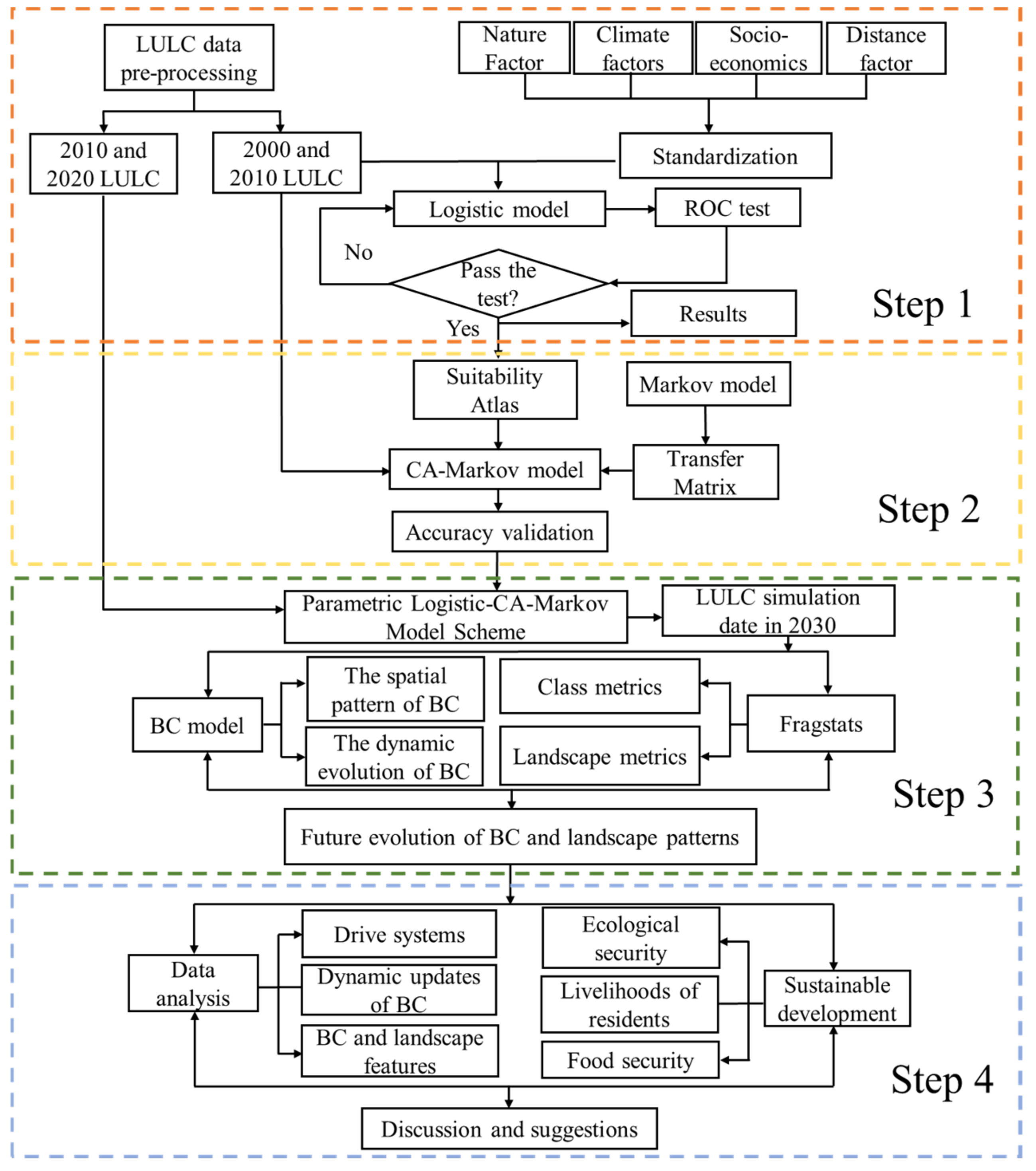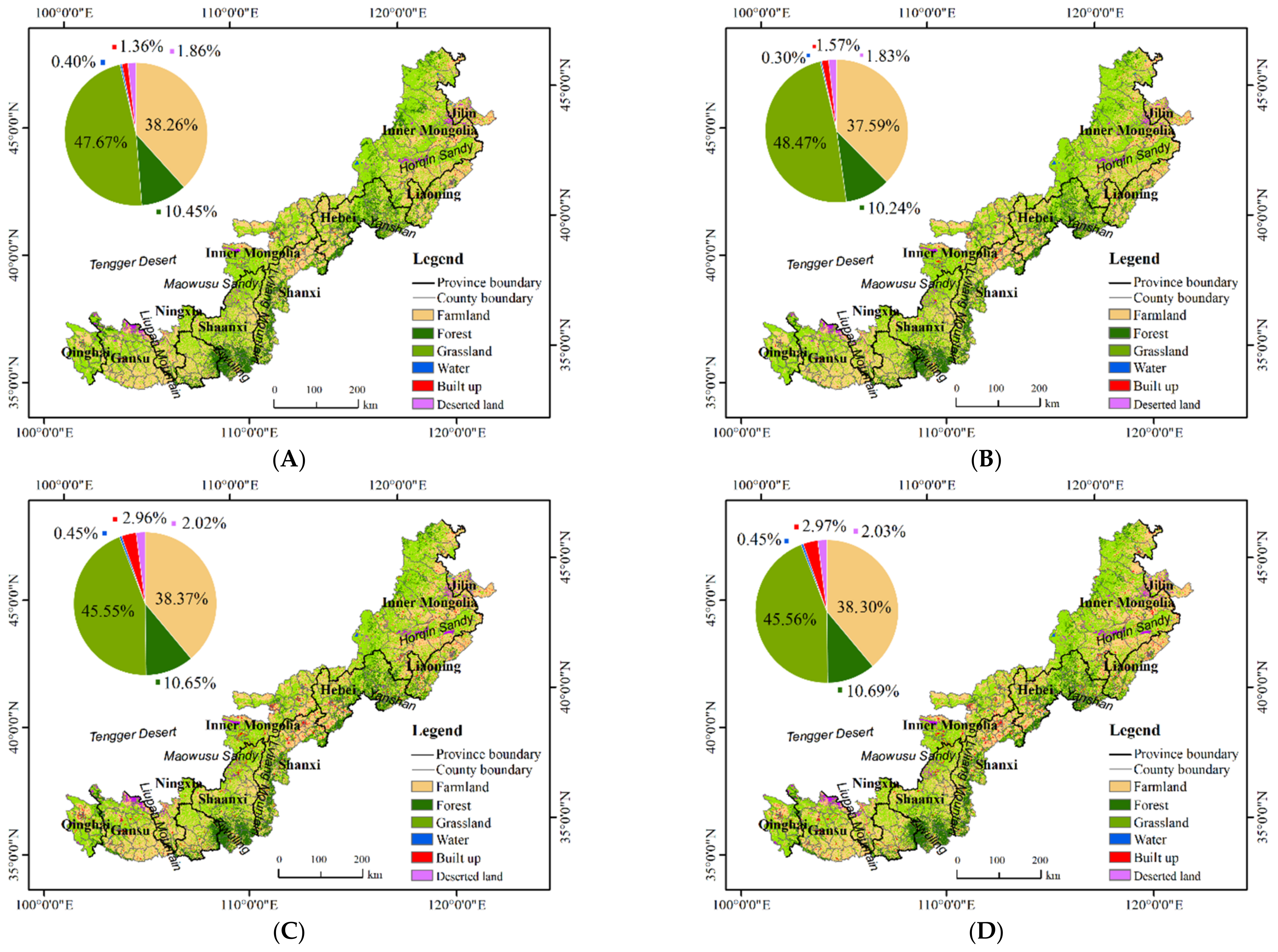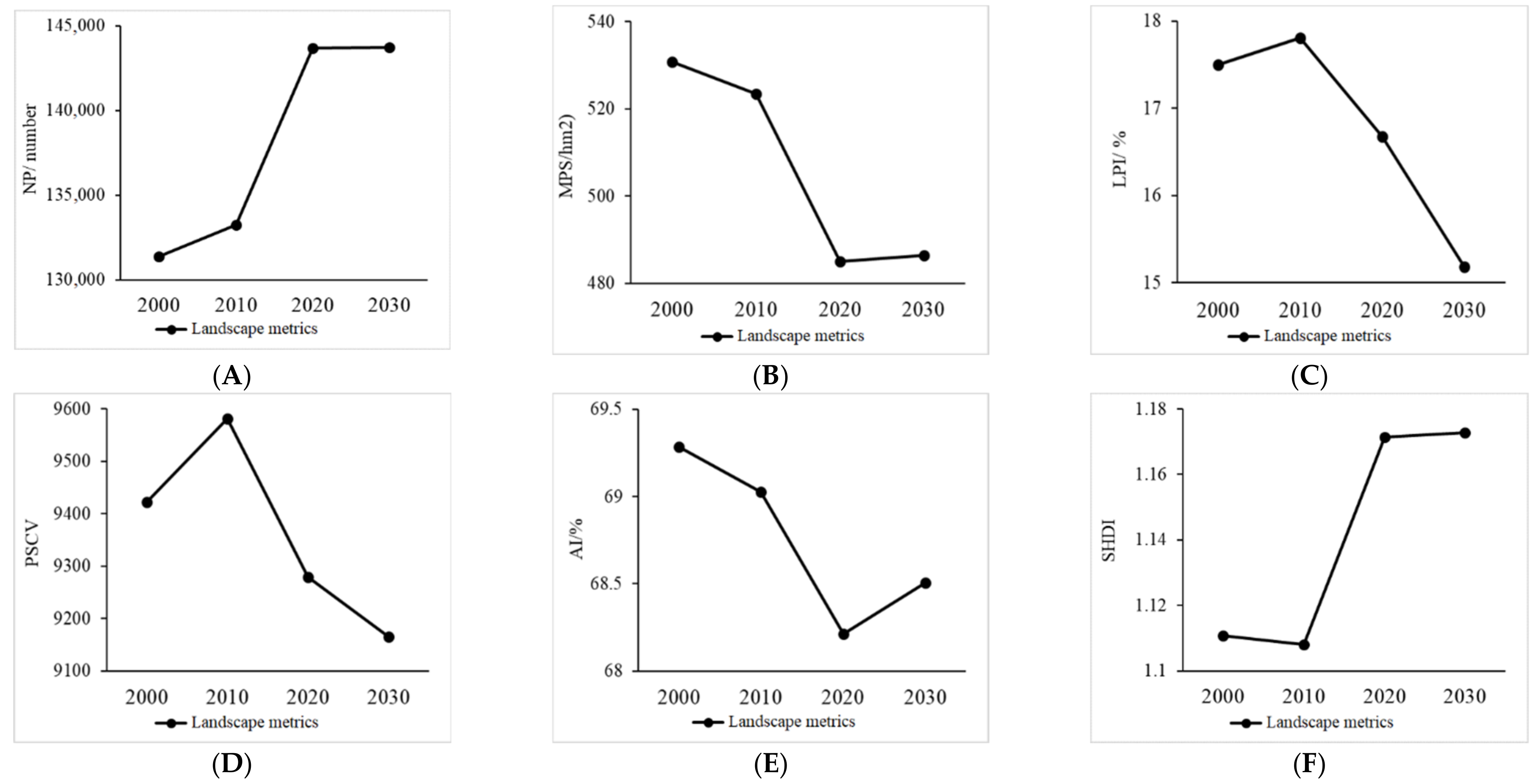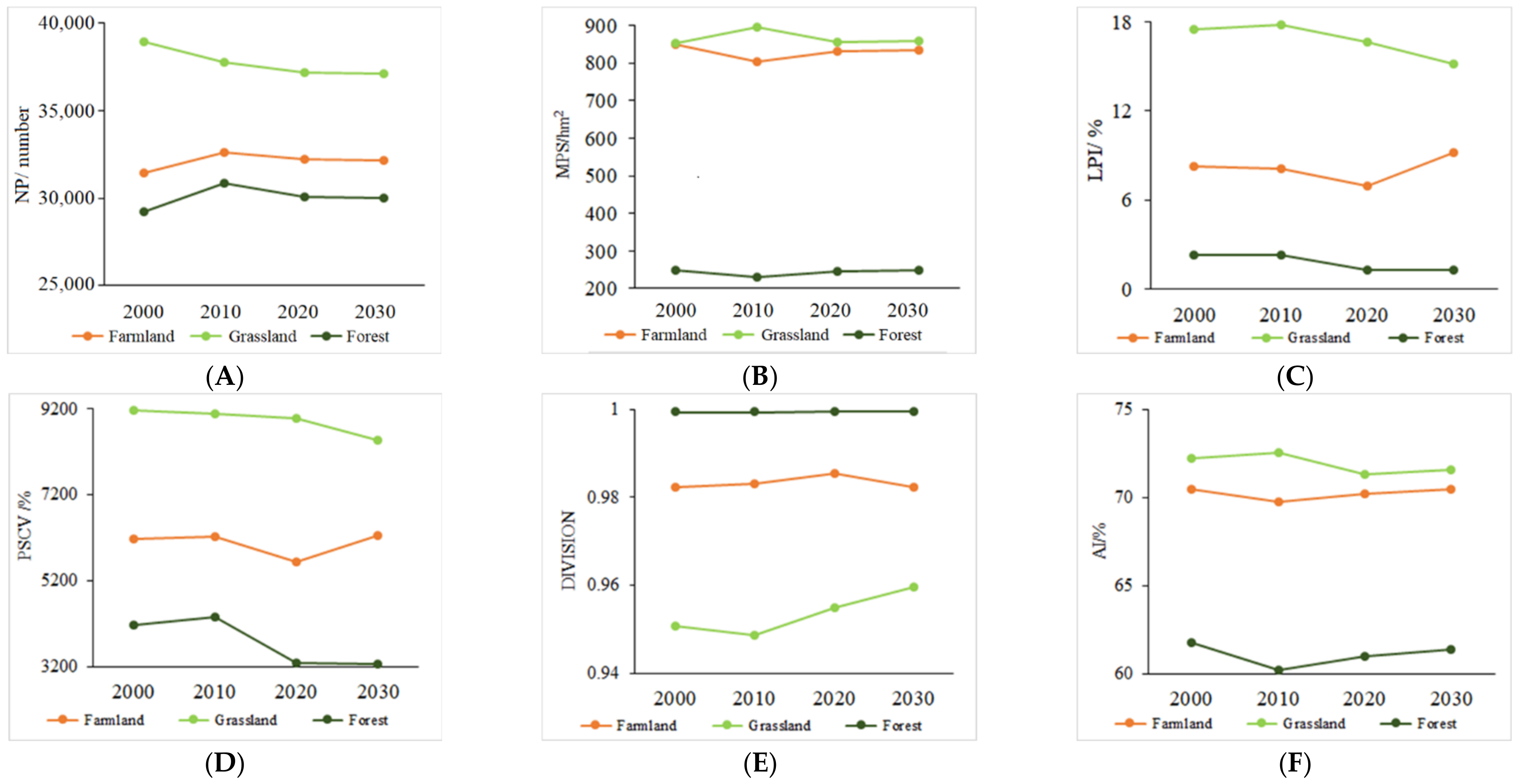Analysis of the Future Evolution of Biocapacity and Landscape Characteristics in the Agro-Pastoral Zone of Northern China
Abstract
:1. Introduction
- (1)
- To construct a set of reasonable and feasible technical routes and parameter schemes for LULC simulations and quantitative measurement of BC.
- (2)
- To analyze BC’s evolutionary patterns, trends, and crucial landscape indices in the AZNC.
2. Study Area, Data, and Methods
2.1. Study Area
2.2. Source of Basic Data
- (1)
- In terms of physical geography, the SRTM DEM data of the study area was downloaded from the Geospatial Data Cloud website (http://www.gscloud.cn/ (accessed on 29 November 2022)) and further calculated to obtain the slope and slope direction.
- (2)
- (3)
- In terms of accessibility, the road data in the study area was downloaded from the Geospatial Data Cloud website (http://www.gscloud.cn/ (accessed on 29 November 2022)) and the distribution of construction land in the study area was extracted from the GlobeLand30 dataset. Finally, the distance from any point in the study area to roads and building sites was calculated in ArcGIS.
- (4)
- In terms of socio-economic development, the 1 km resolution population density and GDP data of the study area for 2010 and 2015 were downloaded from the China Resource and Environment Science and Data Center (http://www.resdc.cn/ (accessed on 29 November 2022)). Population density and GDP data for 2020 were obtained through a linear extrapolation method. We can get the year-end livestock inventory, gross agricultural output, and gross output value of animal husbandry from the statistical yearbooks of the provinces and cities in the study region [44,45,46,47,48,49,50,51] and divide them by the county area. Each province’s ecological engineering construction investment was obtained from the China Statistical Yearbook On Environmental [52]. Then use the area of each county as the weight to obtain each county’s ecological engineering construction investment. Eventually, the number of livestock per unit area, the gross agricultural output per unit area, the gross output value of animal husbandry per unit area, and the total investment in ecological construction based on the county were obtained by spatialization.
2.3. Research Methodology
2.3.1. Technical Route
- (1)
- The three GlobeLand30 periods of 2000/2010/2020 were cropped and reclassified under the size of the study region using ArcGIS, as well as spatialization and standardization factors that affect LULC changes, such as physical topography, climate condition, accessibility, and socio-economic development. After conducting a logistic regression analysis, the ROC curve was used to assess the model fitting effect.
- (2)
- Based on the above logistic model, IDRISI32 [53] helped obtain a suitability atlas for the various theme elements. The CA-Markov module was used to simulate the 2010 LULC data to obtain the results of the LULC in 2020. In order to evaluate the accuracy and dependability of the Logistic-CA-Markov model, the simulated results were compared with GlobeLand30 2020 data.
- (3)
- The CA-Markov module was applied to run simulations using the 2020 LULC data to get the 2030 LULC results based on the above Logistic-CA-Markov parameterization scheme. The spatial distribution of BC and its dynamic evolution process in the study area were examined using reliable institutions’ BC calculation parameter scheme. With the support of Fragstats software [54], a multi-scale landscape index calculation was carried out to analyze the dynamic evolution process of key landscape indices in the study area.
- (4)
- Based on the above process, analysis and discussion were carried out. Suggestions were made from multiple dimensions, such as the driving index system of the simulation system, the dynamic update of BC accounting factors, the necessity for integrated analysis of BC and landscape characteristics, ensuring food security, improving farmers and herdsmen’s livelihood, and maintaining ecological security.

2.3.2. Model Construction
- (1)
- Logistic regression model
- (2)
- CA-Markov model
- (3)
- BC model
- (4)
- Landscape Index
2.3.3. Accuracy Verification
3. Results
3.1. Model Verification and Accuracy Evaluation
3.2. Spatial Distribution and Dynamics of LULC
3.3. Spatial Distribution and Dynamics of BC
3.4. Dynamic Changes in the Landscape Pattern
4. Discussion
4.1. Uncertainty of the Study
4.2. Impact and Recommendations
5. Conclusions
Author Contributions
Funding
Institutional Review Board Statement
Informed Consent Statement
Data Availability Statement
Acknowledgments
Conflicts of Interest
References
- Syphard, A.D.; Clarke, K.C.; Franklin, J. Using a cellular automaton model to forecast the effects of urban growth on habitat pattern in southern California. Ecol. Complex. 2005, 2, 185–203. [Google Scholar] [CrossRef]
- Karimi, F.; Sultana, S.; Babakan, A.S.; Suthaharan, S. An enhanced support vector machine model for urban expansion prediction. Comput. Environ. Urban Syst. 2019, 75, 61–75. [Google Scholar] [CrossRef]
- Veldkamp, A.; Fresco, L.O. CLUE: A conceptual model to study the conversion of land use and its effects. Ecol. Model. 1996, 85, 253–270. [Google Scholar] [CrossRef]
- Verburg, P.H.; Soepboer, W.; Veldkamp, A.; Limpiada, R.; Espaldon, V.; Mastura, S.S.A. Modeling the spatial dynamics of regional land use: The CLUE-S model. Environ. Manag. 2002, 30, 391–405. [Google Scholar] [CrossRef] [PubMed]
- Azizi, A.; Malakmohamadi, B.; Jafari, H. Land use and land cover spatiotemporal dynamic pattern and predicting changes using integrated CA-Markov model. Glob. J. Environ. Sci. Manag. 2016, 2, 223–234. [Google Scholar]
- Morshed, S.R.; Fattah, M.A.; Haque, M.N.; Morshed, S.Y. Future ecosystem service value modeling with land cover dynamics by using machine learning based Artificial Neural Network model for Jashore city, Bangladesh. Phys. Chem. Earth Parts A/B/C 2022, 126, 103021. [Google Scholar] [CrossRef]
- Jafari, M.; Majedi, H.; Monavari, S.M.; Alesheikh, A.A.; Zarkesh, M.K. Dynamic simulation of urban expansion through a CA-Markov model Case study: Hyrcanian region, Gilan, Iran. Eur. J. Remote Sens. 2016, 49, 513–529. [Google Scholar] [CrossRef] [Green Version]
- Aburas, M.M.; Ho, Y.M.; Ramli, M.F.; Ash’Aari, Z.H. Improving the capability of an integrated CA-Markov model to simulate spatio-temporal urban growth trends using an Analytical Hierarchy Process and Frequency Ratio. Int. J. Appl. Earth Obs. Geoinf. 2017, 59, 65–78. [Google Scholar] [CrossRef]
- Li, S.; Liu, X.; Li, X.; Chen, Y. Simulation model of land use dynamics and application: Progress and prospects. J. Remote Sens. 2017, 21, 329–340. [Google Scholar]
- Aburas, M.M.; Ahamad, M.S.S.; Omar, N.Q. Spatio-temporal simulation and prediction of land-use change using conventional and machine learning models: A review. Environ. Monit. Assess. 2019, 191, 205. [Google Scholar] [CrossRef]
- Guan, D.; Zhao, Z.; Tan, J. Dynamic simulation of land use change based on logistic-CA-Markov and WLC-CA-Markov models: A case study in three gorges reservoir area of Chongqing, China. Environ. Sci. Pollut. Res. 2019, 26, 20669–20688. [Google Scholar] [CrossRef]
- Wang, H.; Kong, X.; Zhang, B. The simulation of LUCC based on Logistic-CA-Markov model in Qilian Mountain area, China. Sci. Cold Arid. Reg. 2018, 8, 350–358. [Google Scholar]
- Gharaibeh, A.; Shaamala, A.; Obeidat, R.; Al-Kofahi, S. Improving land-use change modeling by integrating ANN with Cellular Automata-Markov Chain model. Heliyon 2020, 6, e05092. [Google Scholar] [CrossRef]
- Rees, W.E. Ecological footprints and appropriated carrying capacity: What urban economics leaves out. Environ. Urban. 1992, 4, 121–130. [Google Scholar] [CrossRef]
- Ress, W.E.; Wackernagel, M. Ecological footprints and appropriated carrying capacity: Measuring the natural capital requirements of the human economy. Focus 1996, 6, 45–60. [Google Scholar]
- Krausmann, F.; Erb, K.-H.; Gingrich, S.; Haberl, H.; Bondeau, A.; Gaube, V.; Lauk, C.; Plutzar, C.; Searchinger, T.D. Global human appropriation of net primary production doubled in the 20th century. Proc. Natl. Acad. Sci. USA 2013, 110, 10324–10329. [Google Scholar] [CrossRef] [Green Version]
- Rojstaczer, S.; Sterling, S.M.; Moore, N.J. Human appropriation of photosynthesis products. Science 2001, 294, 2549–2552. [Google Scholar] [CrossRef]
- Rudolph, A.; Figge, L. Determinants of ecological footprints: What is the role of globalization? Ecol. Indic. 2017, 81, 348–361. [Google Scholar] [CrossRef]
- Rashid, A.; Irum, A.; Malik, I.A.; Ashraf, A.; Rongqiong, L.; Liu, G.; Ullah, H.; Ali, M.U.; Yousaf, B. Ecological footprint of Rawalpindi; Pakistan’s first footprint analysis from urbanization perspective. J. Clean. Prod. 2018, 170, 362–368. [Google Scholar] [CrossRef]
- Bao, R.; Qiu, S.; Tang, M. Evaluation of ecological carrying capacity in Xilingol League based on DPSIR model. Ecol. Econ. 2020, 36, 139–145. [Google Scholar]
- Kohlheb, N.; Krausmann, F. Land use change, biomass production and HANPP: The case of Hungary 1961–2005. Ecol. Econ. 2009, 69, 292–300. [Google Scholar] [CrossRef]
- Ying, P.; Wu, J.; Xu, Z. Analysis of the tradeoffs between provisioning and regulating services from the perspective of varied share of net primary production in an alpine grassland ecosystem. Ecol. Complex. 2014, 17, 79–86. [Google Scholar]
- Long, A.H.; Wang, H.; Cheng, G.D.; Yu, F.L. Human appropriation of net primary production in the middle reach of Heihe River basin. Chin. J. Appl. Ecol. 2008, 19, 853–858. [Google Scholar]
- Wang, H.; Hu, Y. Simulation of Biocapacity and Spatial-Temporal Evolution Analysis of Loess Plateau in Northern Shaanxi Based on the CA–Markov Model. Sustainability 2021, 13, 5901. [Google Scholar] [CrossRef]
- Rees, W.E.; Wackernagel, M.; Testemale, P. Our Ecological Footprint: Reducing Human Impact on the Earth; New Catalyst Books: Gabriola Island, BC, Canada, 1996. [Google Scholar]
- Liu, M.-C.; Li, W.-H. Calculation of Equivalence Factor Used in Ecological Footprint for China and Its Provinces Based on Net Primary Production. J. Ecol. Rural. Environ. 2010, 26, 401–406. [Google Scholar]
- Liu, M.-C.; Li, W.-H.; Xie, G.-D. Estimation of China ecological footprint production coefficient based on net primary productivity. Chin. J. Ecol. 2010, 29, 592–597. [Google Scholar]
- Li, X.; Lu, L.; Cheng, G.; Xiao, H. Quantifying landscape structure of the Heihe River Basin, north-west China using FRAGSTATS. J. Arid. Environ. 2001, 48, 521–535. [Google Scholar] [CrossRef]
- Maclean, M.G.; Congalton, R.G. PolyFrag: A vector-based program for computing landscape metrics. GIScience Remote Sens. 2013, 50, 591–603. [Google Scholar] [CrossRef]
- Yao, Y.; Cheng, T.; Sun, Z.; Li, L.; Chen, D.; Chen, Z.; Wei, J.; Guan, Q. VecLI: A framework for calculating vector landscape indices considering landscape fragmentation. Environ. Model. Softw. 2022, 149, 105325. [Google Scholar] [CrossRef]
- Dadashpoor, H.; Azizi, P.; Moghadasi, M. Land use change, urbanization, and change in landscape pattern in a metropolitan area. Sci. Total Environ. 2019, 655, 707–719. [Google Scholar] [CrossRef]
- Hu, Y.; Dai, Z.; Guldmann, J.-M. Greenspace configuration impact on the urban heat island in the Olympic Area of Beijing. Environ. Sci. Pollut. Res. 2021, 28, 33096–33107. [Google Scholar] [CrossRef]
- Wilson, M.C.; Hu, G.; Jiang, L.; Liu, J.; Liu, J.; Jin, Y.; Yu, M.; Wu, J. Assessing habitat fragmentation’s hierarchical effects on species diversity at multiple scales: The case of Thousand Island Lake, China. Landsc. Ecol. 2020, 35, 501–512. [Google Scholar] [CrossRef]
- Zhang, M.A.; Borjigin, E.; Zhang, H. Mongolian nomadic culture and ecological culture: On the ecological reconstruction in the agro-pastoral mosaic zone in Northern China. Ecol. Econ. 2007, 62, 19–26. [Google Scholar] [CrossRef]
- Zhang, Q.; Wang, L.; Liu, J. Research on Ecological Security Evaluation of Typical Agricultural and Animal Husbandry Interlaced Areas—A Case Study of Yanchi County of Ningxia Hui Autonomous Region, China. Pol. J. Environ. Studies 2022, 32, 152881. [Google Scholar] [CrossRef]
- Lü, Y.; Fu, B.; Feng, X.; Zeng, Y.; Liu, Y.; Chang, R.; Sun, G.; Wu, B. A Policy-Dr iven Large Scale Ecological Restoration: Quantifying. PLoS ONE 2012, 7, e31782. [Google Scholar]
- Hu, Y.; Gao, M. Batunacun, Evaluations of water yield and soil erosion in the Shaanxi-Gansu Loess Plateau under different land use and climate change scenarios. Environ. Dev. 2020, 34, 100488. [Google Scholar] [CrossRef]
- Tao, Z.; Wang, S.; Sun, P.; Li, K.; Tian, W.; Han, X. Spatio-Temporal Differentiation and Driving Factors of Cropland in the Agro-Pastoral Ecotone of Northern China. Arid. Land Geogr 2022, 45, 153–163. [Google Scholar]
- Chen, J.; Ban, Y.; Li, S. Open access to Earth land-cover map. Nature 2014, 514, 434. [Google Scholar]
- Wang, H.; Hu, Y.; Liang, Y. Simulation and spatiotemporal evolution analysis of biocapacity in Xilingol based on CA-Markov land simulation. Environ. Sustain. Indic. 2021, 11, 100136. [Google Scholar] [CrossRef]
- Xu, X.; Du, Z.; Zhang, H.; Feng, L. Quantitative analysis on driving forces of land use/cover change in north Shanxi province during 1986–2010. China Environ. Sci. 2016, 36, 2154–2161. [Google Scholar]
- Funk, C.; Peterson, P.; Landsfeld, M.; Pedreros, D.; Verdin, J.; Shukla, S.; Husak, G.; Rowland, J.; Harrison, L.; Hoell, A.; et al. The climate hazards infrared precipitation with stations—A new environmental record for monitoring extremes. Sci. Data 2015, 2, 150066. [Google Scholar] [CrossRef] [PubMed] [Green Version]
- Rodell, M.; Kato, H.; Zaitchik, B.F. Ongoing Development of NASA’s Global Land Data Assimilation System. In Proceedings of the 2008 American Geophysical Union Joint Assembly, Fort Lauderdale, FL, USA, 27–30 May 2008. [Google Scholar]
- Gansu YearBook Editorial Board. Gansu Statistical YearBook 2011; China Statistical Press: Beijing, China, 2012.
- Shaanxi Provincial Bureau of Statistics. Shaanxi Provincial Statistical YearBook-2021; China Statistical Press: Beijing, China, 2021.
- Shanxi Provincial Bureau of Statistics. Shanxi Provincial Statistical YearBook-2011; China Statistical Press: Beijing, China, 2011.
- Yanan YearBook Editorial Board. Yanan YearBook 2011; China Statistical Press: Beijing, China, 2011.
- Xining Bureau of Statistics. Xining Statistical YearBook-2021; China Statistical Press: Beijing, China, 2021.
- Hebei Provincial Bureau of Statistics. Hebei Provincial Statistical YearBook-2021; China Statistical Press: Beijing, China, 2021.
- Inner Mongolia Autonomous Region Bureau of Statistics. Inner Mongolia Statistical YearBook-2021; China Statistical Press: Beijing, China, 2021.
- Liaoning Provincial Bureau of Statistics. Liaoning Statistical YearBook-2011; China Statistical Press: Beijing, China, 2011.
- National Bureau of Statistics; Ministry of Environmental Protection. China Statistical YearBook on Environmental-2011; China Statistical Press: Beijing, China, 2011.
- Eastman, J.R. Idrisi32: Guide to GIS and Image Processing; Clark Labs, Clark University: Worcester, MA, USA, 1999; Volume 1–2. [Google Scholar]
- McGarigal, K. FRAGSTATS: Spatial Pattern Analysis Program for Quantifying Landscape Structure; US Department of Agriculture, Forest Service; Pacific Northwest Research Station: Portland, OR, USA, 1995; Volume 351.
- Sang, L.; Zhang, C.; Yang, J.; Zhu, D.; Yun, W. Simulation of land use spatial pattern of towns and villages based on CA–Markov model. Math. Comput. Model. 2011, 54, 938–943. [Google Scholar] [CrossRef]
- Liu, Z.; Li, J. An Analysis and Simulation of Land Use and Landscape Pattern Change in Wuhan City. Sci. Technol. Manag. Land Resour. 2009, 26, 76–79. [Google Scholar]
- Wolfram, S. Statistical mechanics of cellular automata. Rev. Mod. Phys. 1983, 55, 601. [Google Scholar] [CrossRef]
- Batty, M. Cellular automata and urban form: A primer. J. Am. Plan. Assoc. 1997, 63, 266–274. [Google Scholar] [CrossRef]
- Subedi, P.; Subedi, K.; Thapa, B. Application of a hybrid cellular automaton–Markov (CA-Markov) model in land-use change prediction: A case study of Saddle Creek Drainage Basin, Florida. Appl. Ecol. Environ. Sci. 2013, 1, 126–132. [Google Scholar] [CrossRef] [Green Version]
- Mancini, M.S.; Galli, A.; Coscieme, L.; Niccolucci, V.; Lin, D.; Pulselli, F.M.; Bastianoni, S.; Marchettini, N. Exploring ecosystem services assessment through Ecological Footprint accounting. Ecosyst. Serv. 2018, 30, 228–235. [Google Scholar] [CrossRef]
- Jakubowska, J.; Jenkins, M.; Gaillard, V.; Groombridge, B. Living Planet Report 2000; World Wildlife Fund: Gland, Switzerland, 2002. [Google Scholar]
- Almond, R.E.; Grooten, M.; Peterson, T. Living Planet Report 2020-Bending the Curve of Biodiversity Los; World Wildlife Fund: Gland, Switzerland, 2020. [Google Scholar]
- Zhang, M.; Gong, Z.; Zhao, W.; A, D. Landscape pattern change and the driving forces in Baiyangdian wetland from 1984 to 2014. Acta Ecol. Sin 2016, 36, 4780–4791. [Google Scholar]
- Pontius, R.G., Jr.; Schneider, L.C. Land-cover change model validation by an ROC method for the Ipswich watershed, Massachusetts, USA. Agric. Ecosyst. Environ. 2001, 85, 239–248. [Google Scholar] [CrossRef]
- Zheng, F.; Hu, Y. Assessing temporal-spatial land use simulation effects with CLUE-S and Markov-CA models in Beijing. Environ. Sci. Pollut. Res. 2018, 25, 32231–32245. [Google Scholar] [CrossRef]
- Li, K.; Feng, M.; Biswas, A.; Su, H.; Niu, Y.; Cao, J. Driving Factors and Future Prediction of Land Use and Cover Change Based on Satellite Remote Sensing Data by the LCM Model: A Case Study from Gansu Province, China. Sensors 2020, 20, 2757. [Google Scholar] [CrossRef]
- Jeswani, H.K.; Azapagic, A. Water footprint: Methodologies and a case study for assessing the impacts of water use. J. Clean. Prod. 2011, 19, 1288–1299. [Google Scholar] [CrossRef]
- Haddad, N.M.; Brudvig, L.A.; Clobert, J.; Davies, K.F.; Gonzalez, A.; Holt, R.D.; Lovejoy, T.E.; Sexton, J.O.; Austin, M.P.; Collins, C.D.; et al. Habitat fragmentation and its lasting impact on Earth’s ecosystems. Sci. Adv. 2015, 1, 139. [Google Scholar] [CrossRef] [Green Version]
- Li, W.; Cao, Q.; Lang, K.; Wu, J. Linking potential heat source and sink to urban heat island: Heterogeneous effects of landscape pattern on land surface temperature. Sci. Total Environ. 2017, 586, 457–465. [Google Scholar] [CrossRef]






| Code | LULC Type | LC ID | Globeland30 Classification System |
|---|---|---|---|
| 1 | Cultivated land | 10 | Cultivated land |
| 2 | Forest | 20 | Forest |
| 3 | Grassland | 30 | Grassland |
| 40 | Shrub land | ||
| 50 | Wetland | ||
| 4 | Water | 60 | Water bodies |
| 5 | Built up | 80 | Artificial surfaces |
| 6 | Deserted land | 90 | Bare land |
| 100 | Permanent snow and ice |
| Type | Variables | Scale/Resolution | Year | Data Sources |
|---|---|---|---|---|
| Physical Geography | 1. Elevation | 90 m | 2008 | http://www.gscloud.cn/ (accessed on 29 November 2022) |
| 2. Aspect | 90 m | 2008 | http://www.gscloud.cn/ (accessed on 29 November 2022) | |
| 3. Slope | 90 m | 2008 | http://www.gscloud.cn/ (accessed on 29 November 2022) | |
| Climate Conditions | 4. Total precipitation | 0.05 arc degrees | 2010/2020 | https://developers.google.com/earth-engine/datasets (accessed on 29 November 2022) |
| 5. Average annual temperature | 0.25 arc degrees | 2010/2020 | https://developers.google.com/earth-engine/datasets (accessed on 29 November 2022) | |
| Accessibility | 6. Distance to built-up land | 30 m | 2010/2020 | http://www.globallandcover.com/ (accessed on 29 November 2022) |
| 7. Distance to county road | 500 m | 2015 | http://www.gscloud.cn/ (accessed on 29 November 2022) | |
| Socio-Economic Development | 8. Population density | 1000 m | 2010/2020 | http://www.resdc.cn/ (accessed on 29 November 2022) |
| 9. GDP | 1000 m | 2010/2020 | http://www.resdc.cn/ (accessed on 29 November 2022) | |
| 10. Livestock density | County | 2010/2020 | Produced by the authors | |
| 11. Gross agricultural output | County | 2010/2020 | Produced by the authors | |
| 12. Gross output value of animal husbandry | County | 2010/2020 | Produced by the authors | |
| 13. Ecological construction investment | County | 2010/2020 | Produced by the authors |
| LULC Type | 2000 | 2010 | 2020 | 2030 | ||||
|---|---|---|---|---|---|---|---|---|
| YF | EQF | YF | EQF | YF | EQF | YF | EQF | |
| Cultivated land | 2.12 | 2.11 | 2.21 | 2.39 | 2.02 | 2.50 | 2.02 | 2.50 |
| Forest | 1.18 | 1.35 | 1.18 | 1.24 | 1.18 | 1.28 | 1.18 | 1.28 |
| Grassland | 0.81 | 0.47 | 0.81 | 0.51 | 0.81 | 0.46 | 0.81 | 0.46 |
| Water | 1.27 | 0.35 | 1.27 | 0.41 | 1.27 | 0.37 | 1.27 | 0.37 |
| Landscape Index | Scale | Acronyms | Unit | Description |
|---|---|---|---|---|
| Number of Patches | C/L | NP | Number | NP reflects the number of patches of landscape type, with a large NP indicating a high degree of landscape fragmentation. |
| Mean Patch Size | C/L | MPS | hm2 | MPS is the average area of all patches or a particular patch in a landscape and can be used to measure the degree of fragmentation of the landscape. |
| Largest Patch Index | C/L | LPI | % | LPI is the proportion of the entire landscape area occupied by the largest patch of each patch type, and LPI can be used as a measure of the dominant landscape type. |
| Landscape Division Index | C/L | DIVISION | - | DIVISION reflects the extent to which patches of the same category are segmented and isolated from each other, and takes on a range of values: 0 ≤ COHESION <1. |
| Patch Size Coefficient of Variation | C/L | PSCV | - | PSCV is used to characterize the degree of dispersion of the patch area. |
| Aggregation Index | C/L | AI | % | AI is used to describe the degree of agglomeration of different landscape elements, and takes the following values: 0 ≤ AI < 100. |
| Shannon’s Diversity Index | L | SHDI | - | SHDI reflects the degree of homogeneity and complexity of the distribution of the different landscape types in the region and takes the value range: SHDI ≥ 0. |
| Type | Variables | Cultivated Land | Forest | Grassland | Water | Built Up | Deserted Land |
|---|---|---|---|---|---|---|---|
| Physical Geography | 1. Elevation | −0.094 | 0.707 | 0.481 | 1.635 | 4.503 | 1.343 |
| 2. Aspect | 0.46 | −0.31 | −0.156 | 1.069 | 0.671 | −0.267 | |
| 3. Slope | −1.905 | 4.649 | 2.077 | 1.113 | 5.589 | −3.064 | |
| Climate Conditions | 4. Total precipitation | 1.007 | 4.828 | −2.209 | −5.625 | −0.597 | −8.157 |
| 5. Average annual temperature | 2.007 | −1.035 | −1.299 | 6.867 | 3.768 | 2.721 | |
| Accessibility | 6. Distance to built-up land | −1.314 | 1.188 | 1.918 | 3.025 | −21.389 | 2.106 |
| 7. Distance to county road | −0.158 | 1.684 | 2.29 | 0 | 7.457 | 5.319 | |
| Socio-Economic Development | 8. Population density | −0.001 | 0.001 | 0.001 | −0.001 | 0.005 | −0.002 |
| 9. GDP | 0.002 | −0.001 | −0.002 | −0.001 | −0.004 | 0.001 | |
| 10. Livestock density | 0.317 | −8.978 | 0.683 | −1.522 | 0.774 | 0.305 | |
| 11. Gross agricultural output | −4.112 | 1.637 | 2.218 | −1.932 | −0.081 | 2.13 | |
| 12. Gross output value of animal husbandry | 5.105 | 6.993 | −3.428 | 0.662 | 1.3 | −2.01 | |
| 13. Ecological construction investment | −1.31 | 0.348 | 0.527 | −2.012 | −1.993 | −0.425 | |
| ROC (regard to all index) | 0.939 | 0.962 | 0.944 | 0.927 | 0.969 | 0.955 | |
| ROC (without regard to index 11, 12, 13) | 0.924 | 0.959 | 0.936 | 0.921 | 0.958 | 0.955 |
Publisher’s Note: MDPI stays neutral with regard to jurisdictional claims in published maps and institutional affiliations. |
© 2022 by the authors. Licensee MDPI, Basel, Switzerland. This article is an open access article distributed under the terms and conditions of the Creative Commons Attribution (CC BY) license (https://creativecommons.org/licenses/by/4.0/).
Share and Cite
Niu, X.; Hu, Y.; Zhen, L.; Wang, Y.; Yan, H. Analysis of the Future Evolution of Biocapacity and Landscape Characteristics in the Agro-Pastoral Zone of Northern China. Int. J. Environ. Res. Public Health 2022, 19, 16104. https://doi.org/10.3390/ijerph192316104
Niu X, Hu Y, Zhen L, Wang Y, Yan H. Analysis of the Future Evolution of Biocapacity and Landscape Characteristics in the Agro-Pastoral Zone of Northern China. International Journal of Environmental Research and Public Health. 2022; 19(23):16104. https://doi.org/10.3390/ijerph192316104
Chicago/Turabian StyleNiu, Xiaoyu, Yunfeng Hu, Lin Zhen, Yiming Wang, and Huimin Yan. 2022. "Analysis of the Future Evolution of Biocapacity and Landscape Characteristics in the Agro-Pastoral Zone of Northern China" International Journal of Environmental Research and Public Health 19, no. 23: 16104. https://doi.org/10.3390/ijerph192316104





